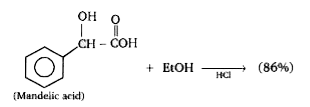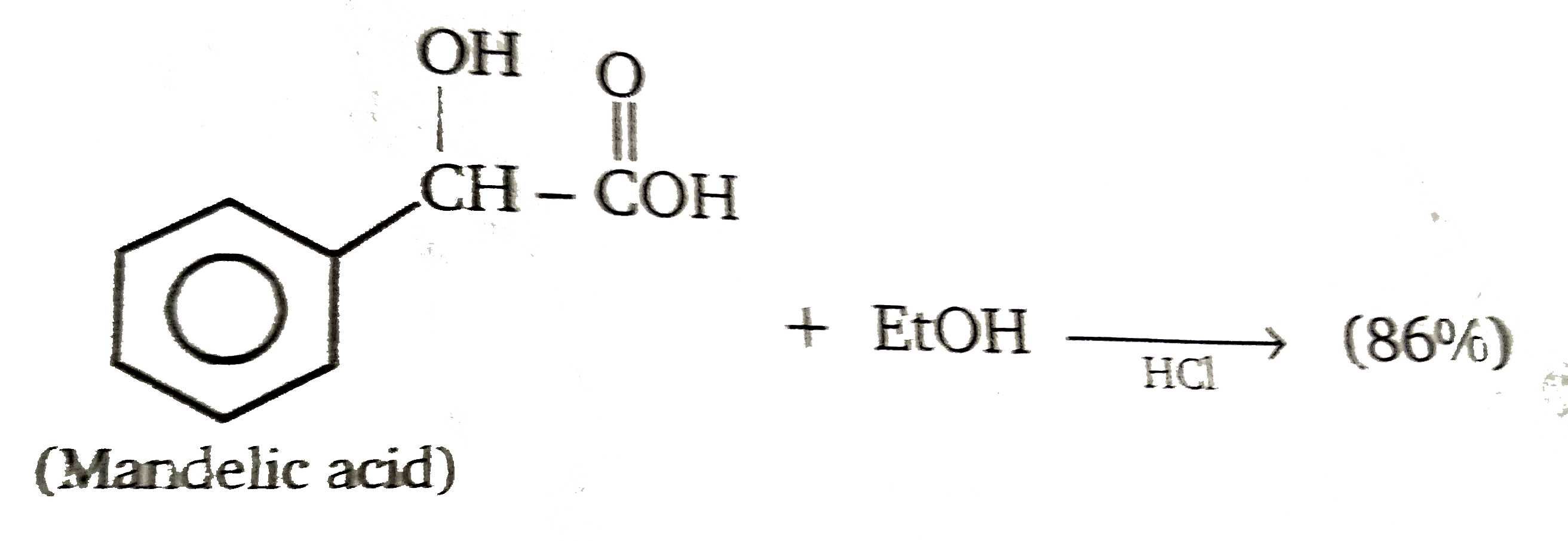In the esterification reaction of alcohols
1∘>2∘>3∘
3∘>2∘>1∘
Same in all cases
2∘>3∘>1∘
The correct Answer is:A
Step-by-Step Solution:
1. Understanding Esterification Reaction:
- Esterification is a chemical reaction between an alcohol and a carboxylic acid (or its derivatives) to form an ester and water. The general reaction can be represented as:
R-OH+R'-COOH→R'-COOR+H2O
- Here, R represents the alkyl group from the alcohol and R' represents the alkyl group from the carboxylic acid.
2. Reactants Involved:
- The reactants in the esterification process can include:
- Alcohols (R-OH)
- Carboxylic acids (R'-COOH)
- Acid chlorides (R'-COCl)
- Acid anhydrides (R'-CO-O-COR')
- The presence of a catalyst, such as concentrated sulfuric acid (H₂SO₄) or pyridine, can help drive the reaction forward by removing water.
3. Mechanism of Reaction:
- In the reaction, the hydroxyl group (-OH) from the carboxylic acid and a hydrogen atom from the alcohol combine to form water (H₂O).
- The remaining parts of the alcohol and carboxylic acid combine to form the ester (R'-COOR).
4. Factors Affecting Esterification:
- The acidity of the alcohol affects the reaction. The order of reactivity for alcohols in esterification is influenced by their structure:
- Primary alcohols (1°) are more reactive than secondary alcohols (2°), which are more reactive than tertiary alcohols (3°).
- This is due to steric hindrance; as the number of alkyl groups around the hydroxyl group increases, the reactivity decreases.
5. Order of Esterification:
- The relative order of esterification for alcohols can be summarized as:
Primary (1°) > Secondary (2°) > Tertiary (3°)
- This means that primary alcohols are the most reactive in esterification reactions, followed by secondary, and tertiary alcohols are the least reactive.
6. Conclusion:
- Therefore, in the esterification reaction of alcohols, the order of reactivity is:
1° Alcohol > 2° Alcohol > 3° Alcohol
- Esterification is a chemical reaction between an alcohol and a carboxylic acid (or its derivatives) to form an ester and water. The general reaction can be represented as:
R-OH+R'-COOH→R'-COOR+H2O
- Here, R represents the alkyl group from the alcohol and R' represents the alkyl group from the carboxylic acid.
- The reactants in the esterification process can include:
- Alcohols (R-OH)
- Carboxylic acids (R'-COOH)
- Acid chlorides (R'-COCl)
- Acid anhydrides (R'-CO-O-COR')
- The presence of a catalyst, such as concentrated sulfuric acid (H₂SO₄) or pyridine, can help drive the reaction forward by removing water.
- In the reaction, the hydroxyl group (-OH) from the carboxylic acid and a hydrogen atom from the alcohol combine to form water (H₂O).
- The remaining parts of the alcohol and carboxylic acid combine to form the ester (R'-COOR).
- The acidity of the alcohol affects the reaction. The order of reactivity for alcohols in esterification is influenced by their structure:
- Primary alcohols (1°) are more reactive than secondary alcohols (2°), which are more reactive than tertiary alcohols (3°).
- This is due to steric hindrance; as the number of alkyl groups around the hydroxyl group increases, the reactivity decreases.
- The relative order of esterification for alcohols can be summarized as:
Primary (1°) > Secondary (2°) > Tertiary (3°)
- This means that primary alcohols are the most reactive in esterification reactions, followed by secondary, and tertiary alcohols are the least reactive.
- Therefore, in the esterification reaction of alcohols, the order of reactivity is:
1° Alcohol > 2° Alcohol > 3° Alcohol
Topper's Solved these Questions
- ALCOHOLS, PHENOLS & ETHERSBOOK - VMC MODULES ENGLISHCHAPTER - ALCOHOLS, PHENOLS & ETHERSEXERCISE - Efficient
98 Videos
- ALCOHOLS, PHENOLS & ETHERSBOOK - VMC MODULES ENGLISHCHAPTER - ALCOHOLS, PHENOLS & ETHERSEXERCISE - Impeccable
100 Videos
- ALCOHOLS, PHENOLS & ETHERSBOOK - VMC MODULES ENGLISHCHAPTER - ALCOHOLS, PHENOLS & ETHERSEXERCISE - Impeccable
100 Videos
- ALCOHOLS, PHENOLS & ETHERS BOOK - VMC MODULES ENGLISHCHAPTER - ALCOHOLS, PHENOLS & ETHERS EXERCISE - IN-CHAPTER EXERCISE - L
10 Videos
- ALDEHYDES,KETONES & CARBOXYLIC ACIDS BOOK - VMC MODULES ENGLISHCHAPTER - ALDEHYDES,KETONES & CARBOXYLIC ACIDS EXERCISE - IN-CHAPTER EXERCISE-M
10 Videos
Similar Questions
Knowledge Check
Order of esterification of alcohols is
A3∘>2∘>1∘B2∘>3∘>1∘C1∘>2∘>3∘Dnone of these. Major product of above esterification reaction is: A
Major product of above esterification reaction is: A B
B C
C D
D

Identify product of above Fischer esterification reaction:APh - overset(O-Et)overset(|)CH-overset()CO_2HB CPh−C∣OHH−CO2EtDPh−C∣OHH−O∣∣C−Et
CPh−C∣OHH−CO2EtDPh−C∣OHH−O∣∣C−Et
A : In esterification reaction alcohol act as nucleophile .
R : In this reaction O - H bond of alcohol is broken .
View SolutionStatement -1 Phenols cannot be converted into esters by direct reaction with carboxylic acids whereas alcohols can be
Statement -2 This is due to the fact that the esterification reaction is exothermic for alcohols but slightly endothermic for phenols.
View SolutionIn esterification reaction, the role of conc. H2SO4 is
View Solution
Identify product of above Fischer esterification reaction :
View SolutionSynthesis of an ester involves the reaction of alcohols with
View Solution